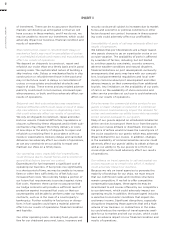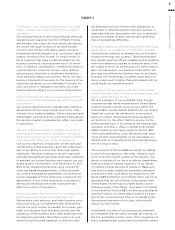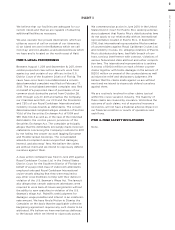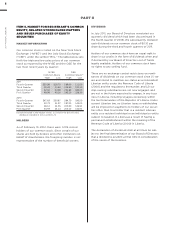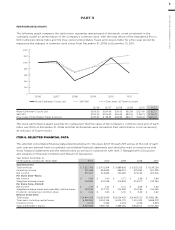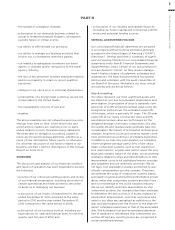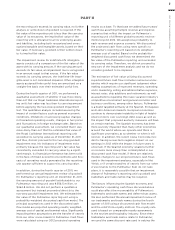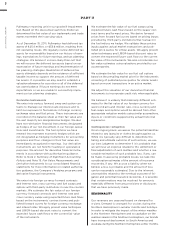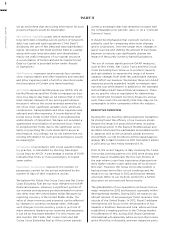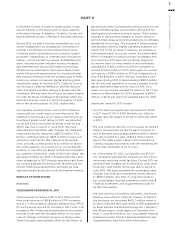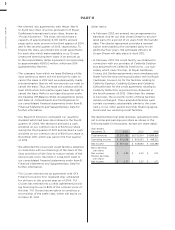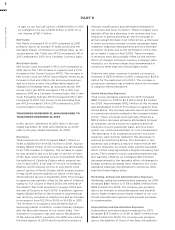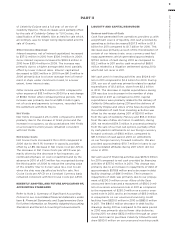Royal Caribbean Cruise Lines 2011 Annual Report Download - page 45
Download and view the complete annual report
Please find page 45 of the 2011 Royal Caribbean Cruise Lines annual report below. You can navigate through the pages in the report by either clicking on the pages listed below, or by using the keyword search tool below to find specific information within the annual report.
PART II
ROYAL CARIBBEAN CRUISES LTD. 41
the reporting unit exceeds its carrying value, no further
analysis or write-down of goodwill is required. If the
fair value of the reporting unit is less than the carrying
value of its net assets, the implied fair value of the
reporting unit is allocated to all its underlying assets
and liabilities, including both recognized and unrec-
ognized tangible and intangible assets, based on their
fair value. If necessary, goodwill is then written down
to its implied fair value.
The impairment review for indefinite-life intangible
assets consists of a comparison of the fair value of the
asset with its carrying amount. If the carrying amount
exceeds its fair value, an impairment loss is recognized
in an amount equal to that excess. If the fair value
exceeds its carrying amount, the indefinite-life intan-
gible asset is not considered impaired. Other intangible
assets assigned finite useful lives are amortized on a
straight-line basis over their estimated useful lives.
During the fourth quarter of 2011, we performed a
qualitative assessment of whether it was more-likely-
than-not that our Royal Caribbean International report-
ing unit’s fair value was less than its carrying amount
before applying the two-step goodwill impairment
test. The qualitative analysis included assessing the
impact of certain factors such as general economic
conditions, limitations on accessing capital, changes
in forecasted operating results, changes in fuel prices
and fluctuations in foreign exchange rates. Based on
our qualitative assessment, we concluded that it was
more-likely-than-not that the estimated fair value of
the Royal Caribbean International reporting unit
exceeded its carrying value as of December 31, 2011
and thus, did not proceed to the two-step goodwill
impairment test. No indicators of impairment exist
primarily because the reporting unit’s fair value has
consistently exceeded its carrying value by a signifi-
cant margin, its financial performance has been solid
in the face of mixed economic environments and fore-
casts of operating results generated by the reporting
unit appear sufficient to support its carrying value.
In addition, during the fourth quarter of 2011, we
performed our annual impairment review of goodwill
for Pullmantur’s reporting unit. At December 31, 2011,
the carrying amount of goodwill attributable to our
Pullmantur reporting unit was €356.5 million, or
$462.8 million. We did not perform a qualitative
assessment but instead proceeded directly to the
two-step goodwill impairment test. We estimated the
fair value of the Pullmantur reporting unit using a
probability-weighted discounted cash flow model. The
principal assumptions used in the discounted cash
flow model are projected operating results, weighted-
average cost of capital, and terminal value. Significantly
impacting these assumptions are the transfer of vessels
from our other cruise brands to Pullmantur. Cash flows
were calculated using our 2012 projected operating
results as a base. To that base we added future years’
cash flows assuming multiple revenue and expense
scenarios that reflect the impact on Pullmantur’s
reporting unit of different global economic environ-
ments beyond 2012. We assigned a probability to
each revenue and expense scenario. We discounted
the projected cash flows using rates specific to
Pullmantur’s reporting unit based on its weighted-
average cost of capital. Based on the probability-
weighted discounted cash flows we determined the
fair value of the Pullmantur reporting unit exceeded
its carrying value. Therefore, we did not proceed to
step two of the impairment analysis and we do not
consider goodwill to be impaired.
The estimation of fair value utilizing discounted
expected future cash flows includes numerous uncer-
tainties which require our significant judgment when
making assumptions of expected revenues, operating
costs, marketing, selling and administrative expenses,
interest rates, ship additions and retirements as well
as assumptions regarding the cruise vacation industry’s
competitive environment and general economic and
business conditions, among other factors. Pullmantur
is a brand targeted primarily at the Spanish, Portuguese
and Latin American markets. European economies
continue to demonstrate instability in light of height-
ened concerns over sovereign debt issues as well as
the impact that proposed austerity measures will have
on certain markets. The Spanish economy has been
more severely impacted than many other economies
around the world where we operate and there is
significant uncertainty as to whether or when it will
recover. In addition, the recent Costa Concordia inci-
dent is having a near-term negative impact on our
earnings in 2012 while the impact in future years is
uncertain. If the Spanish economy weakens further
or recovers more slowly than contemplated in our
discounted cash flow model, if there are relatively
modest changes to our projected future cash flows
used in the impairment analyses, especially in Net
Yields, or if certain transfers of vessels from our other
cruise brands to the Pullmantur fleet do not take
place, it is reasonably possible that an impairment
charge of Pullmantur’s reporting unit’s goodwill and
trademark and trade names may be required.
The factors influencing the Spanish economy and
Pullmantur’s operating cash flows discussed above
could also affect the recoverability of Pullmantur’s
trademarks and trade names and deferred tax assets.
We also performed the annual impairment review of
our trademarks and trade names during the fourth
quarter of 2011 using a discounted cash flow model
and the relief-from-royalty method. The royalty rate
used is based on comparable royalty agreements
in the tourism and hospitality industry. Since these
trademarks and trade names relate to Pullmantur,
we used the same discount rate used in valuing the



